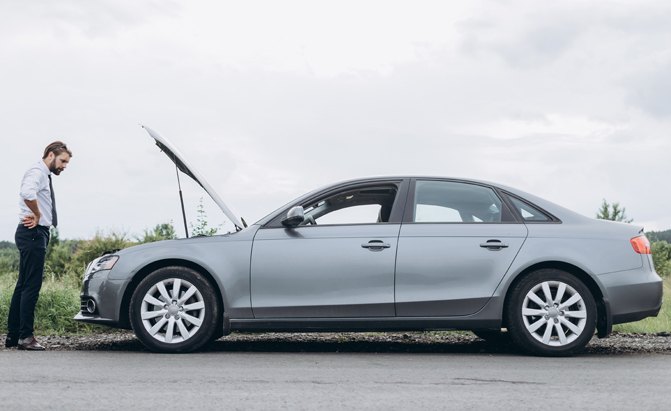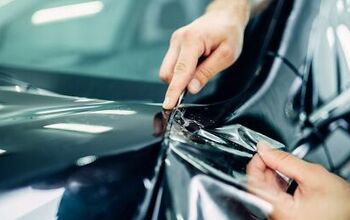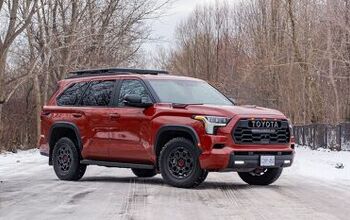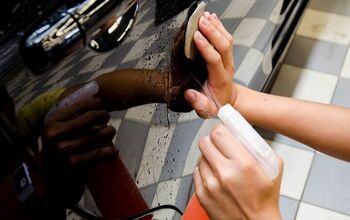10 Car Noises and What They Mean. Plus What to Do About Them
The first time, you weren’t sure if you had heard it or not, but the second time you were a little more sure, and then the thousand times after that it was impossible to ignore. A new noise in your vehicle, one that won’t go away. You could turn up the radio, or you could fix the problem, but how do you know what that noise is? Want to find the source and likely fix for that sound? Here is your guide to 10 of the most common car noises, what they mean, and what you need to do next. We’ve also listed some of the specialty tools you might need to finish the job, in addition to the usual socket set, jack, and jack stands.
Table of contents
Wheel Bearing Whirr
People describe it like being chased by a helicopter. A whirring noise that gets louder and higher-pitched as you go faster, that usually comes from just one side of your car or truck. Though it can be hard to tell where exactly it's coming from, that isn't air support coming in to help you or give you a ticket, it's actually a wheel bearing. How do you test for sure? Turn the wheel gently to the left and then to the right as you drive on a straight road. If it disappears briefly as you turn, that's a good sign you've got a wheel bearing on the way out.
This is one you don't want to ignore, because it can end with your wheel and your vehicle in two different places. Jack up each wheel and give them a firm wobble with your hands at 12 and six. If there's movement, it's time for a new bearing on that wheel. If it gets bad enough, you'll hear it just spinning the wheel by hand. If you replace one, it's probably a good time to replace the other, especially if it's the driver's side that's worn (there are more potholes on the passenger side, so it will follow soon). Use quality bearings, because you don't want to replace them again anytime soon.
Tools You Might Need:
Brake Pad Screech
That screeching and grinding when you tap the brakes? There's a good chance that means you need new brake pads on at least one axle of your car, truck or SUV. It's caused by a small piece of metal called a wear indicator that is bent to let you know your brakes are near the end of their lives. It will get worse and worse until you use up all of the pad material, then the noise gets horrendous as the metal pad backing touches the rotors. At that point you'll need more than just brake pads, you'll need brake rotors or maybe even new brake calipers if you've really ignored the problem.
But check your brake pads before you buy all new parts. If the noise started suddenly, and happens all the time and not just when you're braking, it could be a rock caught in the heat shields behind your brake rotors, and that's much easier (and free) to fix.
Tools You Might Need
Constant Velocity Joint Clicking
Pulling out of a parking space and you hear a clicking that goes away once your wheels are pointed straight? A low-speed clicking that only happens when your wheels are sharply turned is the sound of a constant velocity, or CV joint. These are the shafts that drive the front wheels in your front-wheel drive car or SUV and most AWD or 4x4 models as well. Because your front wheels move up and down as well as turn, CV joints have at least two joints with ball bearings that help the axle components flex.
If you're hearing that clicking, take a look at the rubber boots next to your brakes and near the transmission. If the boots are cracked and slinging grease, you can add grease and replace them, but if they're making that noise it's already too late. New CV joints are the ticket, and while you can replace just the ball bearings, replacing the entire shaft is much quicker, much easier, and, more importantly, a whole lot cleaner.
Tools You Might Need
Drive Belt Squeal
A horrible squeal each time you start your vehicle that might go away after a few minutes? That sounds like a problem in your accessory drive. Your accessory drive system includes parts like the fan belt, if you still have one of those, but also the serpentine belt that drives your alternator and air conditioning compressor as well as those parts that are being driven. A misaligned belt could cause the noise, but it's most likely time for a new belt and a new belt tensioner. That part, which keeps the belt tight and on the right track, can fail and leave your accessory belt flapping and squeaking. If you want to narrow down which pulley is squeaking, a mechanic's stethoscope lets you put the tip on each pulley (be careful of the spinning belt) and know exactly what part is making noise.
Tools You Might Need
Power Steering Whine
Hear a whine like that start-up belt noise, but instead of happening when you start your ride, it happens every time you turn the wheel? Oh, and the wheel is suddenly almost impossible to turn? That's a power steering pump, and there are a few ways to take care of this one. The reason for the noise is usually low fluid in the pump, and it's not happy because it is pumping air. So check your fluid level and top it up with the right power steering fluid. The right fluid is often right on the cap. If it starts up again a little while later, you're leaking fluid somewhere. It could be a power steering line, a cooling line, the pump, or even the rack itself. Look for the wet spots and you'll find the leak. A leaky line is an easy fix, but if the steering rack itself is leaking you're in for some more work. If you hear a whine from inside your vehicle, that's probably one of your passengers. Try a soda, some snacks, or slowing down a touch.
Tools You Might Need
Underbody Flapping
Driving down the highway and it sounds like a drummer is going to town on your floorboards? Especially if it's recently rained or snowed, it's probably one of the many underbody shields has come loose and is now flapping in the breeze. Do you absolutely need these plastic panels designed to shield water and help your vehicle's aerodynamics? Not necessarily, but your vehicle will not be the same without them. And you don't want to drag them on the ground. Catch it early enough and you'll be able to pop the plastic panels into place. You'll probably need some new clips, though, usually a handful is all that holds in the panel.
Tools You Might Need
Rattles After the Thump
A rattle the instant after you hit a pothole or speed bump can be infuriating. Why is my truck making noise AFTER I hit something? If this sounds like your ride, it's likely a problem with your exhaust system. Because the exhaust is isolated from the rest of your vehicle, there is a slight delay before the rattle. Common exhaust issues include broken exhaust hangars, which attach the pipes to your car, or a problem with a heat shield. Especially in the salt belt, catalytic converter heat shields are prone to rusting and breaking away from their mounting points, causing that rattle as they hit the body of the car or the catalytic converter itself.
Tools You Might Need
- Propane torch (these bolts are likely rusted beyond removal)
- Grinder (see above)
- Exhaust hanger removal tool
Other accessories
Slow-Speed Suspension Clunk
A clunk from the front or rear of your car that happens when you turn the wheel, but you can hear it even if your car isn't moving? Sometimes it makes that same clunk when you drive over a bump at lower speeds? That sound is likely coming from your suspension, and it could be one of a few things. The easiest to check is a broken spring. Lift up each corner of the vehicle and look for a spring that is broken in two. It's easy to see on a coil, but still can be spotted on a truck leaf spring. If all of the springs look fine, then your next step is the shock and strut mounts. These hold the shock absorber to body of the vehicle, and at the front allow the steering wheels to turn. A failure here is common and easy to fix, usually with new mounts.
Tools You Might Need
Startup Straight-Pipe Road
If you get in your vehicle one morning and it suddenly sounds like you're driving a Harley Davidson motorcycle, we've got bad news for you. If your vehicle is suddenly extra loud, you've probably just found an expensive problem. If you're lucky, it's a new hole in your exhaust pipe or muffler, and you'll need to replace them. Mufflers and pipes aren't usually repairable. If you're not lucky, it means that someone has taken your catalytic converter, and you're in for an expensive repair. For this one, you might want to call your insurer before the parts store.
Tools You Might Need
- Phone (to call your insurer)
- Exhaust and tailpipe cutter
- Exhaust hanger removal tool
- Exhaust pipe expander
Tick, Tick, Tick, go the Injectors
A slight ticking noise from under your hood is normal, especially on a newer vehicle. Direct injection gasoline engines have high-pressure fuel injectors that make an audible tick when they fire. A louder tick, or one that gets louder as the engine revs and becomes more frequent could be something more serious. A loud tick is likely something mechanical. Step one, check your engine oil level, because if it's low then you might solve the problem with the right amount of oil. If that doesn't fix it, you may have low oil pressure or a valvetrain problem and need some more serious work.
Tools You Might Need
Download the eBay Motors App
To make life easier when it comes to getting everything you need for your car or truck, consider downloading the eBay Motors App.
More than just a parts catalog app, the eBay Motors app gives you access to one of the largest selections of parts and accessories in the world. You can also buy and sell vehicles and connect directly with automotive enthusiasts right from your phone.
Take advantage of the My Garage feature to easily store your vehicle’s specs so you can quickly find and buy the parts you want. You can store multiple vehicles in your profile, which means you don’t have to re-input the same information every time you use the app. Plus, eBay’s fitment feature ensures you will find the parts that will fit your vehicle.
Another great feature on the app for vehicle sellers is the ability to upload a picture of your license plate, which eBay then uses to grab all the pertinent details of your vehicle for selling, including uploading your VIN number.
Download the eBay Motors app today.
We are committed to finding, researching, and recommending the best products. We earn commissions from purchases you make using the retail links in our product reviews. Learn more about how this works.
Photo credit: Vera Petrunina / Shutterstock.com
Evan moved from engineering to automotive journalism 10 years ago (it turns out cars are more interesting than fibreglass pipes), but has been following the auto industry for his entire life. Evan is an award-winning automotive writer and photographer and is the current President of the Automobile Journalists Association of Canada. You'll find him behind his keyboard, behind the wheel, or complaining that tiny sports cars are too small for his XXXL frame.
More by Evan Williams










































Comments
Join the conversation